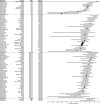The protective effectiveness of control interventions for malaria prevention: a systematic review of the literature
- PMID: 29259767
- PMCID: PMC5721947
- DOI: 10.12688/f1000research.12952.1
The protective effectiveness of control interventions for malaria prevention: a systematic review of the literature
Abstract
Background: Thanks to a considerable increase in funding, malaria control interventions (MCI) whose efficacy had been demonstrated by controlled trials have been largely scaled up during the last decade. Nevertheless, it was not systematically investigated whether this efficacy had been preserved once deployed on the field. Therefore, we sought the literature to assess the disparities between efficacy and effectiveness and the effort to measure the protective effectiveness (PE) of MCI. Methods: The PubMed database was searched for references with keywords related to malaria, to control interventions for prevention and to study designs that allow for the measure of the PE against parasitemia or against clinical outcomes. Results: Our search retrieved 1423 references, and 162 articles were included in the review. Publications were scarce before the year 2000 but dramatically increased afterwards. Bed nets was the MCI most studied (82.1%). The study design most used was a cross-sectional study (65.4%). Two thirds (67.3%) were conducted at the district level or below, and the majority (56.8%) included only children even if the MCI didn't target only children. Not all studies demonstrated a significant PE from exposure to MCI: 60.6% of studies evaluating bed nets, 50.0% of those evaluating indoor residual spraying, and 4/8 showed an added PE of using both interventions as compared with one only; this proportion was 62.5% for intermittent preventive treatment of pregnant women, and 20.0% for domestic use of insecticides. Conclusions: This review identified numerous local findings of low, non-significant PE -or even the absence of a protective effect provided by these MCIs. The identification of such failures in the effectiveness of MCIs advocates for the investigation of the causes of the problem found. Ideal evaluations of the PE of MCIs should incorporate both a large representativeness and an evaluation of the PE stratified by subpopulations.
Keywords: case-control studies; health surveys; indoor residual spraying; insecticide-treated bed nets; intermittent preventive treatment; malaria; prevention and control; protective effectiveness.
Conflict of interest statement
Competing interests: No competing interests were disclosed.
Figures








Similar articles
-
Post-deployment effectiveness of malaria control interventions on Plasmodium infections in Madagascar: a comprehensive phase IV assessment.Malar J. 2016 Jun 16;15:322. doi: 10.1186/s12936-016-1376-5. Malar J. 2016. PMID: 27306378 Free PMC article.
-
Effectiveness of malaria control interventions in Madagascar: a nationwide case-control survey.Malar J. 2016 Feb 11;15:83. doi: 10.1186/s12936-016-1132-x. Malar J. 2016. PMID: 26867661 Free PMC article.
-
Coverage of intermittent preventive treatment and insecticide-treated nets for the control of malaria during pregnancy in sub-Saharan Africa: a synthesis and meta-analysis of national survey data, 2009-11.Lancet Infect Dis. 2013 Dec;13(12):1029-42. doi: 10.1016/S1473-3099(13)70199-3. Epub 2013 Sep 18. Lancet Infect Dis. 2013. PMID: 24054085 Review.
-
Cost-effectiveness of malaria control in sub-Saharan Africa.Lancet. 1999 Jul 31;354(9176):378-85. doi: 10.1016/s0140-6736(99)02141-8. Lancet. 1999. PMID: 10437867
-
Measuring and characterizing night time human behaviour as it relates to residual malaria transmission in sub-Saharan Africa: a review of the published literature.Malar J. 2019 Jan 11;18(1):6. doi: 10.1186/s12936-019-2638-9. Malar J. 2019. PMID: 30634963 Free PMC article. Review.
Cited by
-
Differential Influence of Environmental Factors on Malaria Due to Vector Control Interventions in Uganda.Int J Environ Res Public Health. 2023 Nov 9;20(22):7042. doi: 10.3390/ijerph20227042. Int J Environ Res Public Health. 2023. PMID: 37998273 Free PMC article.
-
Health gains and financial risk protection afforded by public financing of selected malaria interventions in Ethiopia: an extended cost-effectiveness analysis.Malar J. 2020 Jan 23;19(1):41. doi: 10.1186/s12936-020-3103-5. Malar J. 2020. PMID: 31973694 Free PMC article.
-
Accounting for regional transmission variability and the impact of malaria control interventions in Ghana: a population level mathematical modelling approach.Malar J. 2020 Nov 23;19(1):423. doi: 10.1186/s12936-020-03496-y. Malar J. 2020. PMID: 33228659 Free PMC article.
-
Increasing challenges of malaria control in sub-Saharan Africa: Priorities for public health research and policymakers.Ann Med Surg (Lond). 2022 Aug 18;81:104366. doi: 10.1016/j.amsu.2022.104366. eCollection 2022 Sep. Ann Med Surg (Lond). 2022. PMID: 36046715 Free PMC article.
-
Factors associated with malaria in pregnancy among women attending ANC Clinic in Kwadaso Municipality, Ghana: a health facility based cross-sectional study.BMC Public Health. 2025 Apr 30;25(1):1595. doi: 10.1186/s12889-025-22810-4. BMC Public Health. 2025. PMID: 40307776 Free PMC article.
References
-
- WHO Global Malaria Programme: World Malaria Report 2014. Geneva;2014. Reference Source
-
- WHO Global Malaria Programme: Malaria Control in Humanitarian Emergencies: An Inter-Agency Field Handbook. (Second Edition), Geneva: World Health Organization;2013. Reference Source
-
- Hill N, Zhou HN, Wang P, et al. : A household randomized, controlled trial of the efficacy of 0.03% transfluthrin coils alone and in combination with long-lasting insecticidal nets on the incidence of Plasmodium falciparum and Plasmodium vivax malaria in Western Yunnan Province, China. Malar J. 2014;13:208. 10.1186/1475-2875-13-208 - DOI - PMC - PubMed
LinkOut - more resources
Full Text Sources
Other Literature Sources

